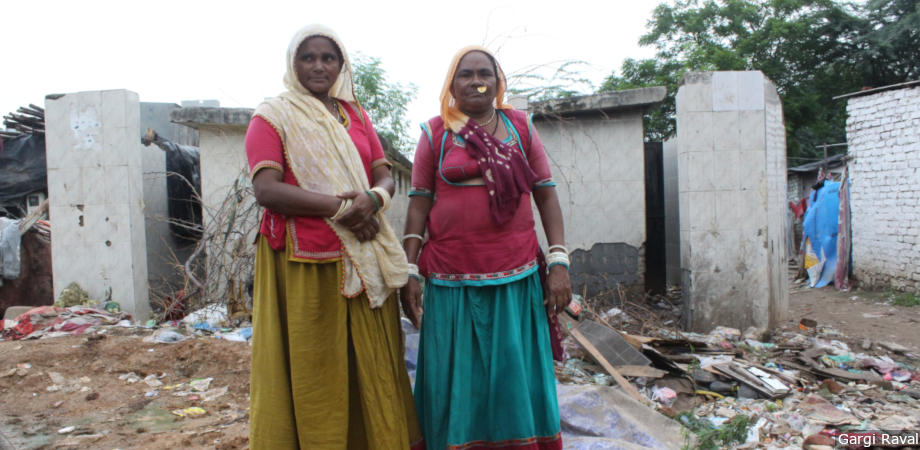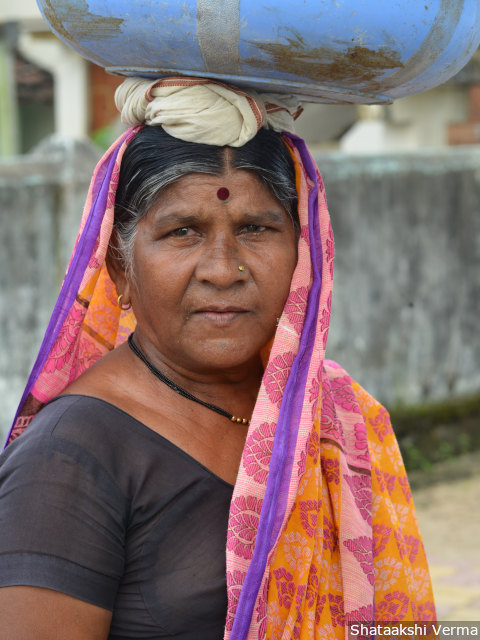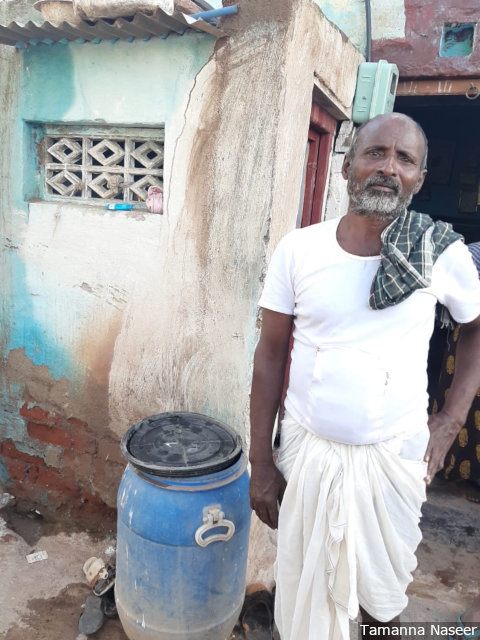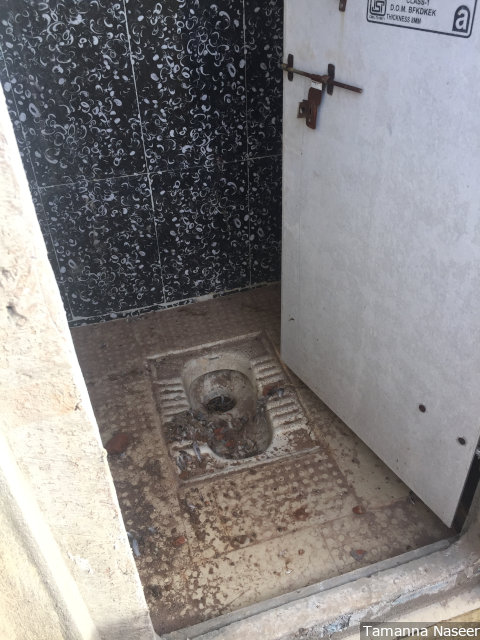110 Million Toilets Built, But Claim That India Free Of Open Defecation Not True

Hansaben Bhati, 46 (left), stands in front of a dilapidated toilet in Vasna, in Ahmedabad, Gujarat, on Sept. 26, 2019. Bhati says she feels ashamed of defecating in the open but community toilets in this condition are impossible to use.
Ahmedabad, Mumbai, Chandrapur (Maharashtra), Rohtak (Haryana), Bagalkot (Karnataka) & Lucknow: Shakuntala Meshram, 55, of Vedwa village in Maharashtra’s Chandrapur district, walks more than a kilometre every morning to defecate in the open. It has been five years since the government conducted the Swachh Bharat Mission (Clean India Mission or SBM) survey, but she hasn’t received funds to construct a toilet.
"My family doesn't have the money to construct the toilet on our own, and our name hasn’t appeared in the (beneficiary) list even after applying many times,” said Meshram, an agricultural labourer.
Today, on Oct 2, 2019, at an event in Gujarat, attended by 20,000 village chiefs and international dignitaries in Gujarat, India’s prime minister, Narendra Modi, is expected to make the announcement that India is free of open defecation (ODF). The announcement comes five years after the launch of SBM.
But our investigation in Gujarat, Maharashtra, Haryana, Karnataka and Uttar Pradesh over the last week of September 2019 found missing toilet subsidies, half-constructed and neglected toilets, lack of water in toilets, and open defecation, both out of choice and because of the lack of an alternative, contrary to the Prime Minister’s claims.
About three fourths (71%) of the rural population in four states--Madhya Pradesh, Rajasthan, Uttar Pradesh and Bihar--owned a toilet, but just over half actually used one, found researchers from the Research Institute for Compassionate Economics (RICE) during a survey of 1,550 households in 2018. In 56% of households, at least one member of each household defecates in the open, the study found. These states have two-fifths of India’s population.
Kapurdas Meshram, the Gram Panchayat (village committee) official at Vedwa, told FactChecker.in that they have recently submitted a new list to the administration listing the villages which still don’t have toilet facilities. "The process will be fast now as it’s going to be online now," he said.

Shakuntala Meshram, 55, of Vedwa village of Maharashtra’s Chandrapur district, says she waited for five years to receive government funds to construct a toilet. She still defecates in the open as her family can’t afford to build a toilet.
Instead of behaviour change, SBM focused on constructing toilets
As many as 64.3 million toilets were built between 1999 and 2012 of the Total Sanitation Mission. More than 100 million household toilets have been constructed since 2014 under SBM, as per official government figures.
But SBM has the same problem as its predecessor, the Total Sanitation Campaign, as IndiaSpend reported on October 1, 2019. A randomised evaluation of the Total Sanitation Campaign (with a similar focus on financial subsidies) conducted between 2009 and 2011 in Madhya Pradesh showed that among two groups of villages with similar initial proportions of latrine-owning households, the programme increased the coverage of latrines by 26 percentage points, whereas coverage increased by 3 percentage points in the group in which the programme was not implemented.
Yet, reduction in open defecation did not match the increase in new latrine coverage. More than 70% of the population in the villages that received the programme continued to defecate in the open. Of those households that had improved sanitation facilities, 41% still defecated in the open, daily.
The proportion defecating in the open had fallen to 56% in 2018, the RICE study found, showing that SBM has had some success increasing the reach of toilets. But almost a quarter (23%) of those who own a latrine defecate in the open, a figure that has remained unchanged between 2014 and 2018, the RICE survey found.
The government does not agree. Independent surveys have confirmed that more than 90% of those with access to sanitation use them, Parameshwar Iyer, secretary, department of drinking water and sanitation, told IndiaSpend in October 2018.
Yelappa Uppar, 55, of Bagalkot district, Karnataka, has a toilet in his house, which he constructed four years ago, with a government subsidy of Rs 12,000. He invested Rs 8,000 of his own into the toilet, he said. But Uppar said he does not use the toilet daily, as its septic tank and pits get clogged if the family uses it too frequently. The toilet in the house is only used in cases of an emergency or at nighttime. Even his neighbours have stopped using their toilet for the same reason, Uppar said.
The Panchayat (village) Development Officer Laxman Shantagari, however, blamed the attitude of the villagers and claimed that people make excuses like unavailability of water. He said door-to-door campaigns to create awareness and regular meetings in Panchayats (village committee) are conducted to convince people to get rid of the age-old practice of open defecation.
“The focus is on creation of complete ODF villages, rather than only on construction of individual toilets. This entails triggering the entire village into changing their behaviour rather than dealing individually with beneficiaries...reduction in diarrhea and improved health parameters result only when the village (entire communities) has become completely ODF i.e. 100% of the villagers use toilets 100% of the time,” wrote the joint secretary of SBM-rural in a letter to all principal secretaries of SBM rural, on June 9, 2015.
The government defines ODF as no ‘faecal-oral’ transmission’, and under the SBM guidelines, should be verified by two things: no visible faeces in the environment and every household, and all institutions should be using safe technology for the disposal of faeces. Safe disposal of faeces would mean no contamination of surface soil, groundwater or surface water; excreta inaccessible to flies or animals; no handling of fresh excreta; and freedom from odour and ‘unsightly condition’.
Still, in villages, ODF declarations were based on completion of construction of toilets in households that didn’t have latrines in the baseline survey conducted in 2012, as we reported on November 2018.

Yalappa Uppar, 55, of Bagalkot, Karnataka, has a toilet in his house but because it gets clogged, he has stopped using it regularly. Even as official figures say that 100 million toilets have been built since 2014, many are unused.
Lack of Sewage
The problem of liquid waste management exists across India. No more than 56.4% of urban homes--where 377 million people live--are connected to sewer lines while only 36.7% of rural areas--where 833 million people live--have drainage, according to a 2017 national sample report, the latest data available, Factchecker.in reported on October 2, 2018.
Twin-pit toilets, ‘safe technologies’ under SBM guidelines, are not commonly constructed. No more than 13% of toilets had twin pits, while 38% had septic tanks with soak pits and 20% had single pits--both damaging to the environment--according to an IndiaSpend analysis of raw data from the National Annual Rural Sanitation Survey, 2017-18--an independent verification survey often cited by the government--which surveyed 92,040 households across 6,136 villages.
On September 27, 2019, the department of drinking water and sanitation, now called the Ministry of Jal Shakti, released the ten-year national rural sanitation strategy (2019-2029) that focuses on sustainability of latrine infrastructure, including retro-fitting and repairs, behavior change communication and solid and liquid waste management.
Neglected and non-existent toilets
The Ahmedabad Municipal Corporation declared itself ODF in January 2019, but over 1,000 people were defecating in the open, owing to the lack of toilet facilities, a city-based non-governmental organisation found, as reported by the Daily News and Analysis on March 10, 2019.
Community toilets in the Vasna area, which has 265 huts of daily-wage labourers, living for over a decade, were in a state of neglect, our investigation found.
“Anyone can see the toilet units are without water connection and are in bad shape. We don’t like to defecate in the open. We do care for our own health and hygiene, but the lack of empathy from the civic body is forcing us to do so,” said Dala Gama, 49, a resident of the area, and a daily-wage labourer. “We have also learnt that the toilet units are going to be demolished for the road-widening work. So tell us where we should go,” he asked.
“It is extremely shameful for us when people see us carrying mugs and tumblers. Many times, men and women sit next to each other as there is no other option. During our periods and at night, we try and control the impulse,” said Hansaben Bhati, 46, another resident.
In three other areas--Torrent Power House, D-Cabin in Sabarmati and Zundal Cross in Chandkheda--there were no community toilets or mobile toilets.
Denying these cases of open defecation in the city, Harshad Solanki, the director of Solid Waste Management at Ahmedabad Municipal Corporation, told FactChecker.in, “We have ODF++ status. Sometimes reporters ask small kids to give a pose.”
When the reporter mentioned that she had seen people defecating in the open, he did not respond.
Our investigation found similar instances in Bagalkot district in Karnataka where residents said a community toilet had not been completed despite repeated requests to the local Panchayat (village committee) Development Officer.
Karnataka became the 26th state to achieve ODF status on November 19, 2018. The HD Kumaraswamy government had claimed that all the 72.2 lakh rural households in the state were provided with toilets.
One of the community toilets in the area, which is clean and has water, is in a remote area and does not have light bulbs. The other toilet, closer to the village has no taps and dirty toilets.
It is difficult to construct individual toilets in the area because the design of the government-suggested toilets is not easy to make in the rocky geography, and officials decided to build community toilets instead, local Zilla (local area) officials told FactChecker.in.
The Panchayat development officer, Laxman Shantagari, told FactChecker.in that the government was trying to ensure proper maintenance of the community toilets. “Now, I have appointed sweepers to maintain community toilets. The half-constructed compound will also be complete by October 5,” he said.
But “the villagers show no interest in maintaining community toilets,” Shantagiri said.

A poorly maintained toilet in Bagalkot, Karnataka, Sept 27, 2019.
Pay-to-go toilets unaffordable
Priya Kanaujiya, 13, looks for vacant plots or walks to the railway line a km away to defecate. Her father, Manoj, is a washerman, and the family lives in a makeshift house in a vacant plot in Gomti Nagar, in Uttar Pradesh’s capital city Lucknow, and cannot afford a house with a toilet.
A public toilet, about two km from their house charges Rs 5 per use. With his meagre income, he cannot afford the Rs 25 a day it would take for his family of five to use the toilet every morning.
Lucknow mayor Sanyukta Bhatia told FactChecker.in that she was not aware of the fact that people are still defecating in the open because of a lack of public toilets. She said she would look into the matter. “The problem could be that these people do not live in Gram Panchayat (village) areas, otherwise they would have got the toilets. They are living in the area which is under the Lucknow Development Authority. We will look into it and provide the facility of bio-toilets for them," she said.
Bureaucratic Corruption
During their survey, RICE researchers also conducted a qualitative study of 156 government officials and panchayat representatives. In these interviews, many officials emphasised that the open defecation status is “only on paper” and has little connection to reality.
Villagers in Chandrapur alleged that they did not receive a subsidy to build toilets. Officials would ask them to first build the toilet, and then get a reimbursement from the Panchayat, which never materialised. Most households who are yet to receive the benefit from the scheme are either economically poor or belong to the Scheduled Tribe community, according to a village official who said he noted this pattern.
"On paper, it has been declared as ODF a long time ago, but this is all for the sake of the documentation. On paper anything can be shown,” a Panchayat official said, on the condition of anonymity.
A Gram Sevak (village worker) with the local Panchayat told FactChecker.in that since the Panchayat does not decide the list of beneficiaries, many villagers could be missing from the list.
A district official agreed that the list of beneficiaries was altered to be able to declare the village ODF. Many beneficiaries were removed from the list in order to make the number small and then match it with the number of toilets constructed in that village, which would help the village declare itself ODF, he explained.
Coercion common
There was pressure to declare villages, blocks and districts ODF, and coercive practices like threats, abuse, as well as actual denial of legal entitlements in the public distribution system were used to construct or use the toilets, found the RICE study.
“We found that 12% of the households had faced coercion in the Swachh Bharat Mission, and more than half had heard of coercion happening in their village,” said Aashish Gupta, the lead author of the paper, research fellow at RICE, and a doctoral candidate at the University of Pennsylvania.
While Dalits were almost twice as likely to have faced coercion, Adivasis (those belonging to government-recognised tribes) were more than three times as likely to have faced coercion, the study found.
Caste beliefs play a role in toilet usage
The low toilet use can partly be attributed to deeply entrenched beliefs about caste “impurity” associated with emptying latrine pits, the RICE 2018 study said.
“Instead of challenging social inequality or notions of purity and pollution, coercive practices in the Swachh Bharat Mission have also reinforced caste and social inequality,” Gupta said.
Hindu households more likely to defecate in the open than Muslim households. Hindu households with larger pits were less likely to defecate in the open than those with smaller pits. This was linked to the fact that smaller pits required frequent emptying, which is associated with caste impurity, said the 2018 RICE study.
The SBM-recommended twin-pit latrine is designed in such a way that emptying of the filled pit can be done safely and inexpensively, precluding the need to hire manual scavengers. However, misconceptions about the capacity of such toilets have led to individuals erroneously modifying twin-pit latrines to create seemingly larger pits, making these latrines more expensive and unsafe to clear. This in turn brings the risk of perpetuating manual scavenging or open defecation as the preferred alternative, as IndiaSpend reported on October 1, 2019.
Households that built their own latrines spent Rs. 34,000--almost three times the government subsidy of Rs. 12,000--to accommodate bigger pits.
Only 1% of respondents said they emptied their toilet pits on their own, while 86% said they would call manual scavengers to empty their pits when required, according to a 2017 study conducted in Rajasthan by Accountability Initiative. About 13% either did not respond to the question or said they would revert to open defecation when such a time came.
Similarly, most households reported relying on hiring someone for pit emptying, not always waiting till decomposition was complete, found a 2017 study in Bihar by the International Initiative for Impact Evaluation.
“These results suggest the need for future sanitation programming to focus on knowledge of decomposition rates, correct disposal of faecal matter and emphasis on ease of self-emptying. Sanitation programming must recognise deep seated social and caste biases which require sanitation to be treated as a social as well as a health issue” said the study.
(Raval, Mangal, Verma, Singh, Naseer, Somareddi and Sharma are members of 101Reporters.com, a pan-India network of grassroots reporters. Yadavar is a special correspondent with IndiaSpend.)
We welcome feedback. Please write to respond@indiaspend.org. We reserve the right to edit responses for language and grammar.


